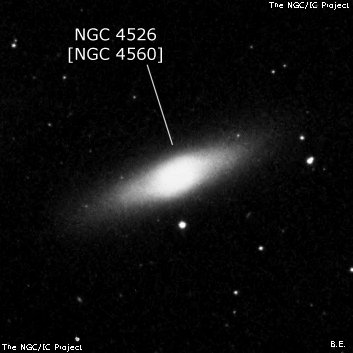
NGC 4526 (also listed as NGC 4560) is a lenticular galaxy with an embedded dusty disc, located approximately 55 million light-years from the Solar System in the Virgo constellation and discovered on 13 April 1784 by William Herschel.The galaxy is seen nearly edge-on. The morphological classification is SAB(s)0°, which indicates a lenticular structure with a weak bar across the center and pure spiral arms without a ring. It belongs to the Virgo cluster and is one of the brightest known lenticular galaxies. In the galaxy's outer halo, globular cluster orbital velocities indicate abnormal poverty of dark matter: only 43±18% of the mass within 5 effective radii. The inner nucleus of this galaxy displays a rise in stellar orbital motion that indicates the presence of a central dark mass. The best fit model for the motion of molecular gas in the core region suggests there is a supermassive black hole with about 4.5+4.2−3.0×108 (450 million) times the mass of the Sun. This is the first object to have its black-hole mass estimated by measuring the rotation of gas molecules around its centre with an astronomical interferometer (in this case the Combined Array for Research in Millimeter-wave Astronomy). Supernova SN 1969E was discovered in this galaxy in 1969, reaching a peak magnitude of 16. In 1994, a type Ia supernova was discovered about two weeks before reaching peak brightness. Designated SN 1994D, it was caused by the explosion of a white dwarf star composed of carbon and oxygen.
400/500mm - 17.5" (4/18/87): very bright, fairly large, very elongated WNW-ESE, bright core, strong stellar nucleus. A mag 12.5 star is 1.3' S of center. Located midway between mag 6.9 SAO 119466 7.6' W and mag 6.7 SAO 119479 7.2' ENE. Supernova 1994C observed at 12th magnitude on 3/12/94 five days after discovery.
600/800mm - 24" (5/20/17): very bright, very large, very elongated 3:1 WNW-ESE, ~3.75'x1.25'. Contains a large, rounder core with a small intense nucleus that seems slightly offset south of center. The extensions gradually fade out towards the tips. Situated at the midpoint of mag 7.0 HD 109285 7.5' WSW and mag 6.8 HD 109417 7.3' ENE. NGC 4518 lies 15' NW.